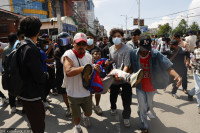Editorial
Kathmandu has been declared open defecation-free, maybe prematurely
At present, there are only 37 public toilets in Kathmandu. Given this, the claim that Kathmandu is now open-defecation free sounds bogus..jpg&w=900&height=601)
In 2011, the government embarked on a long-term Sanitation and Hygiene Master Plan, which included eliminating open defecation by providing access to toilets and proper sanitation by 2017. The target, however, was pushed back two years after the 2015 earthquake. The deadline is now September 2019. So far, a total of 63 districts have been declared open defecation-free zones since the government launched the campaign 15 years ago; and yesterday, the Capital was declared an open defecation-free area too. While it is good to be part of the coveted club, the decision, it seems, has come prematurely.
The Kathmandu Valley has an acute shortage of toilets. Or rather, well-functioning toilets. Taking cognisance of this, Kathmandu Metropolitan City had been directed to construct toilets in 41 places across the Valley. But even two years after the idea germinated, the project has not been able to take shape. There are public restrooms in many places in Kathmandu and Lalitpur. But the number still looks insufficient. According to WaterAid’s report entitled World’s Toilet 2017, there is only one public toilet per every 46,000 people in the Kathmandu Valley—where more than 4.5 million people are estimated to live. At present, there are only 37 public toilets in Kathmandu. Given this, the claim that Kathmandu is now open-defecation free sounds bogus.
Public toilets are few and far between in the city, forcing many poor, homeless and landless squatters to defecate in public. Owing to lack of toilets, many residents still resort to answering the call of nature in the open. Usually at night. For example, when one walks on the overhead bridges in the wee hours, foul smells of urine and faeces make it difficult to even breathe. The sight there is repulsive.
The common perception is that building lavatories will be enough to solve the problem of open defecation. While this step is important and does make a difference, to truly make the city open defecation-free, the focus should be on increasing civic sense and bringing about behavioural changes. What’s more, the issue should be looked at from a larger perspective of hygiene and sanitation of which water supply is a major part. Merely building toilets will do little to solve the problem if the government fails to ensure that there is proper water supply in every household.
There is a long way to go if Kathmandu is to truly become an open defecation-free area. The authorities' decision to declare Kathmandu so might have also been motivated by the fact that Visit Nepal 2020 is approaching, and this could be one of the planks on which to promote the city. Kathmandu did lag far behind in efforts to meet the country’s required sanitation targets. But merely announcing that people no longer answer nature’s call in the open will not do much to serve the intended purpose.
***
What do you think?
Dear reader, we’d like to hear from you. We regularly publish letters to the editor on contemporary issues or direct responses to something the Post has recently published. Please send your letters to [email protected] with "Letter to the Editor" in the subject line. Please include your name, location, and a contact address so one of our editors can reach out to you.




 10.12°C Kathmandu
10.12°C Kathmandu














